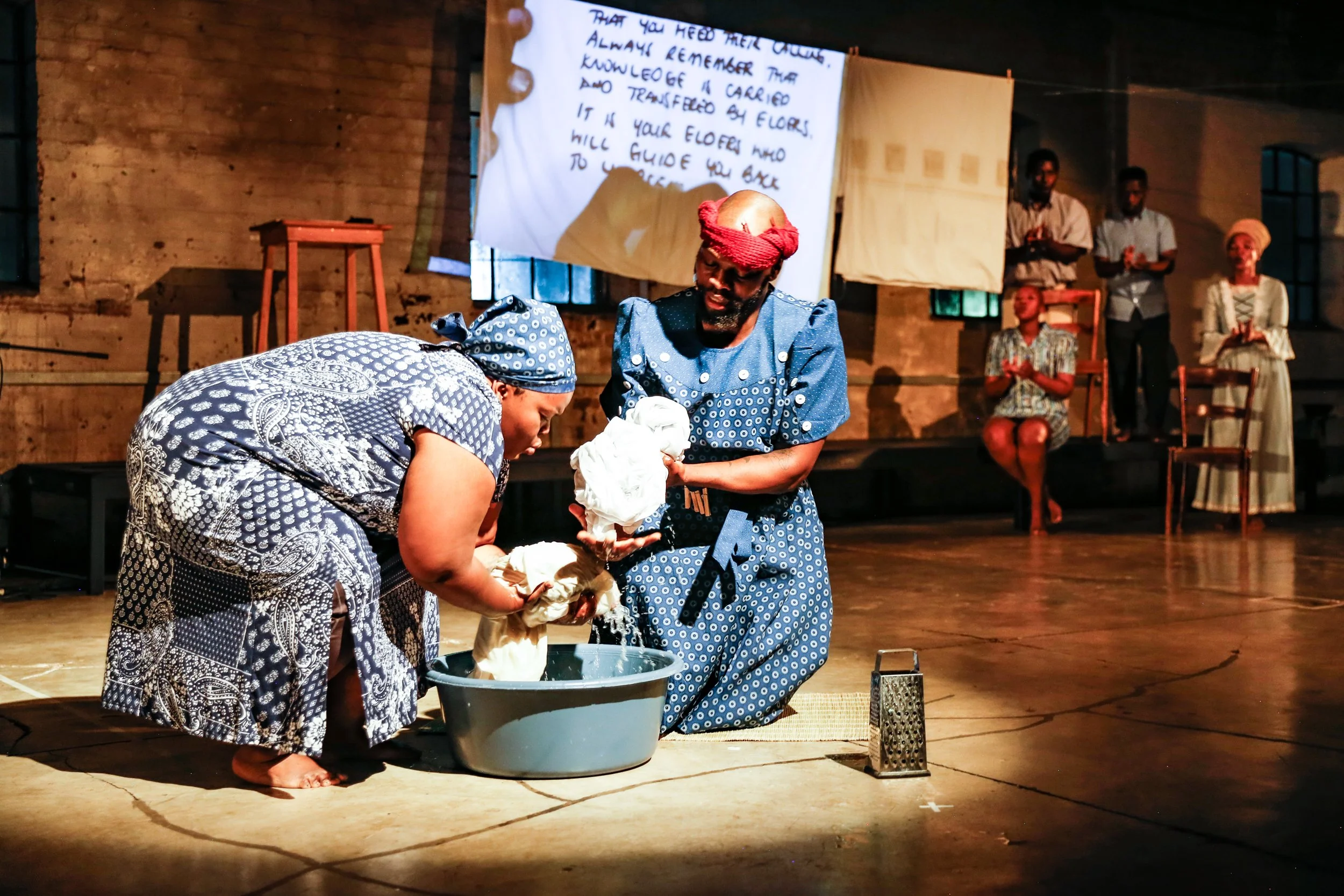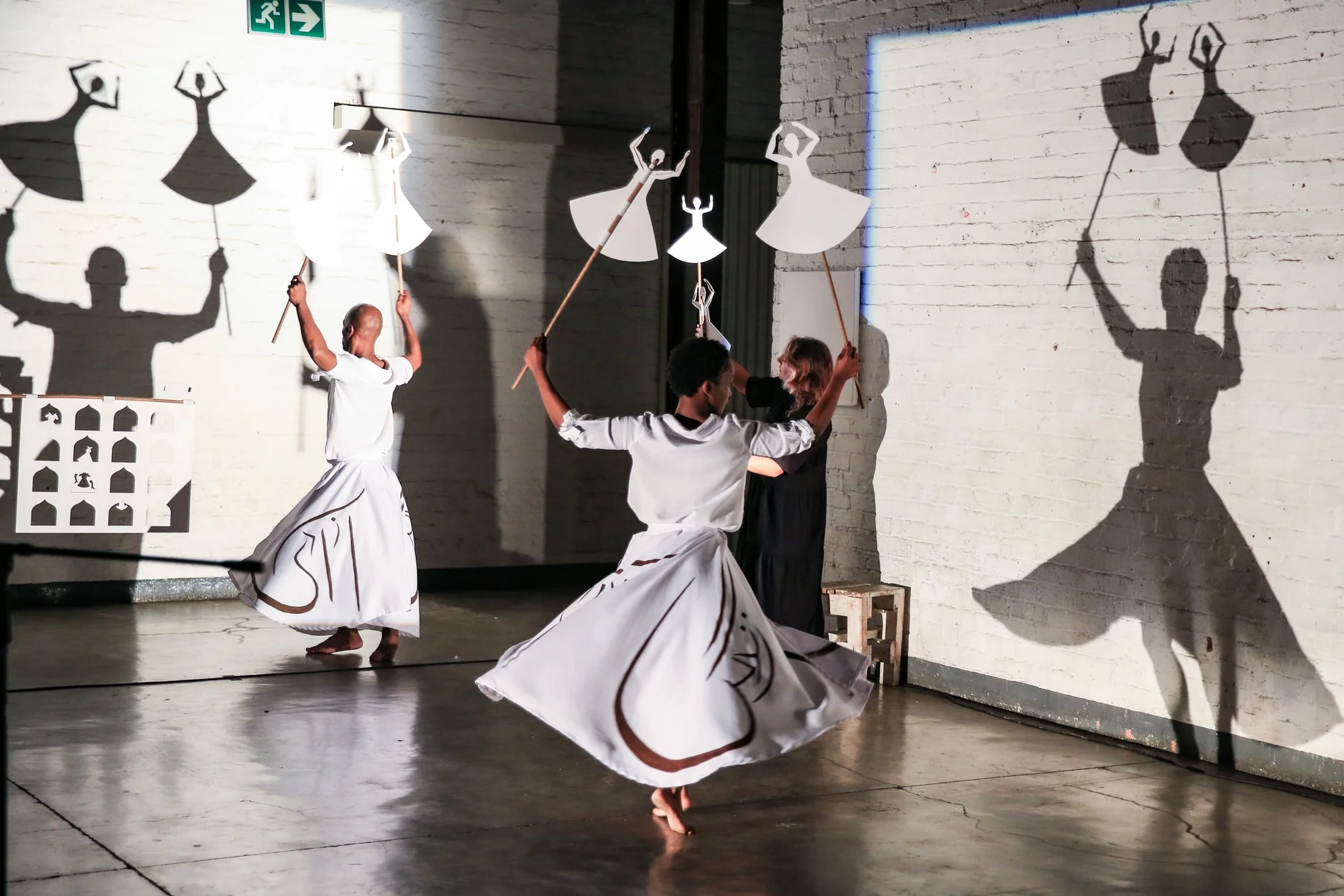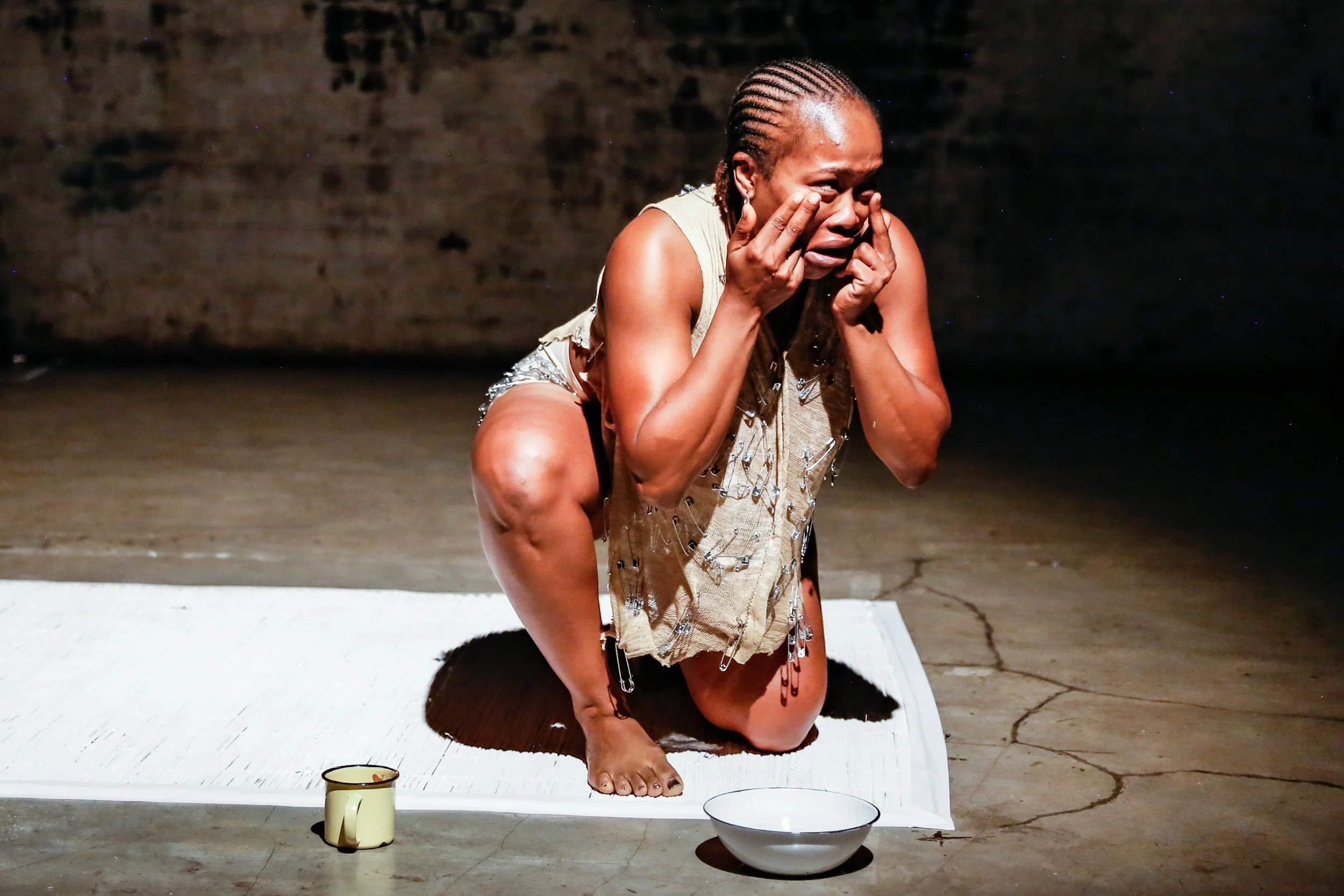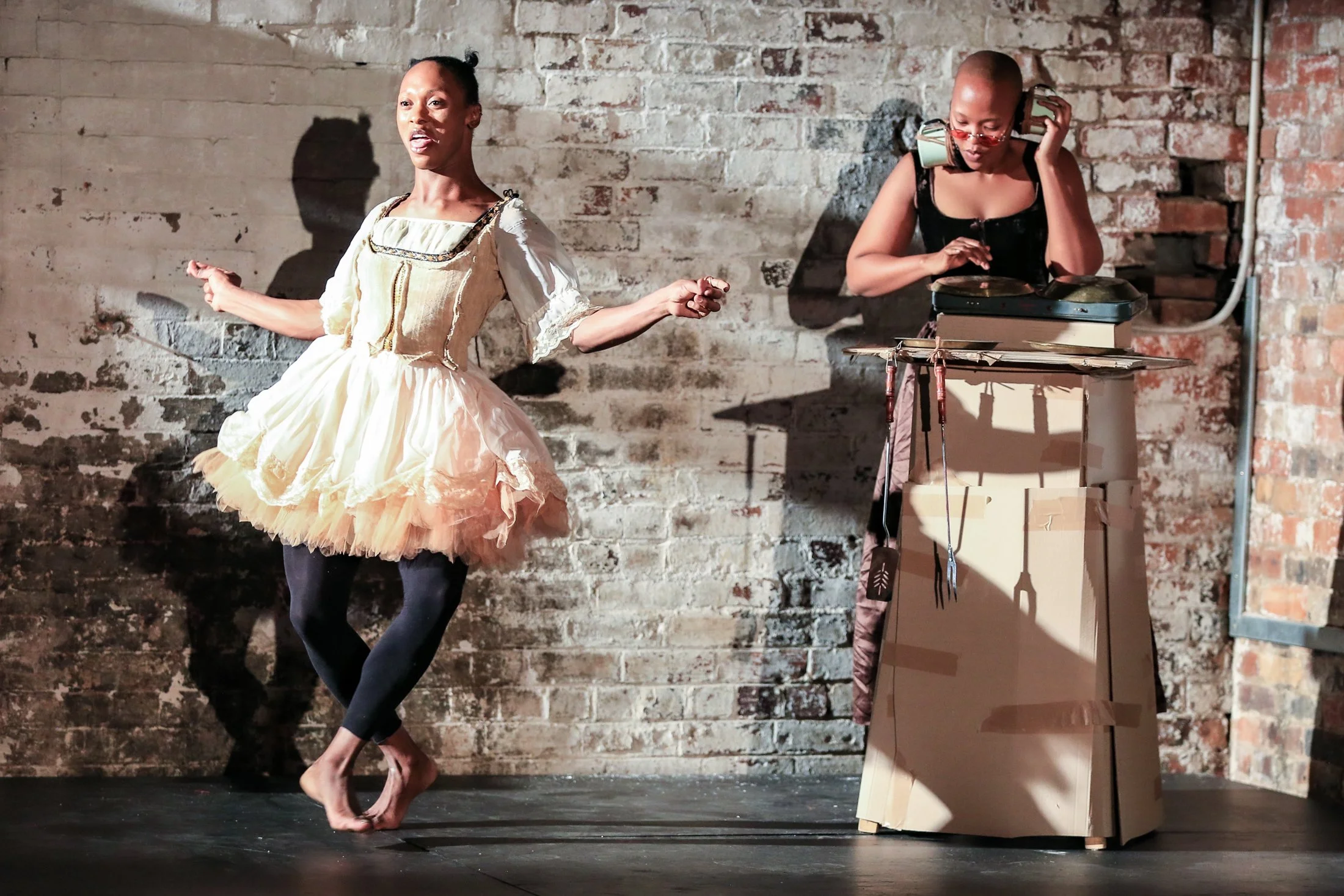NEXT TO YESTERDAY TODAY | PELE HA MAOBANE KAJENO | À CÔTÉ D'HIER AUJOURD'HUI is a collection of stories, fragments and reflections on how we are translated across generations, spaces and time. Pieces about lineage, family, memory and migration are translated into and against the present.
IMPHANDE
Two cloaked figures (Thulisile Binda and Muzi Shili) sit in a basin, surrounded by language, music and the distinctive smell of imphepho. They are intertwined, bound by duty. When they do eventually move, it is in unison – slowly, delicately.
Throughout the performance, the narrative choreography of Shili and Binda is bolstered by the responsive music of the nyunga-nyunga (Cara Stacey) and the unique percussive possibilities of water (Xolisile Bongwana) as well as the spoken word (Indalo Stofile). The result is a compelling and novel meditation on how the responsibilities and ways of being from one’s home impacts us throughout our adult lives.
Through its use of live music and considered movement, Imphande plays with notions of gender, independence, duty and expectation to pose the question of how much we are programmed by the cultures of our home spaces.
– David Mann
CREDITS:
PERFORMERS | Thulisile Binda, Muzi Shili & Indalo Stofile
MUSICIANS | Cara Stacey & Xolisile Bongwana
CONCEPTUALISER | Thulisile Binda
KAMO, ETLA KAMO
A desire to actively recall and re-member is at the heart of Kamo, etla kamo, a performance that centres, among other things, memory, family, labour, community and the reclamation of language.
A performance full of tenderness, held in recollections of childhood and the everyday languages and gestures of care, Kamo etla kamo is a brief and compelling work. Conceptualised and led by Kamogelo Molobye, the performance makes use of simple, but effective visuals to hold its narrative.
A chorus of actors, for example, provide the work with its vital musicality, but in their stillness, they also come to resemble photographs from a family album. Sheets spread out and suspended on a string become washing lines, room dividers as well as canvases for projection, evoking the ethereality of memory.
Always, through its use of the language of the voice and the body, Kamo etla kamo returns to a central point: knowledge, in its myriad forms, is held and transferred by the elders.
– David Mann
CREDITS:
PERFORMERS | Kamogelo Molobye, Nomcebisi Moyikwa, Anathi Conjwa, Zimbini Makwetu, Thabo Rapoo, Indalo Stofile & Xolisile Bongwana
CONCEPTUALISER | Kamogelo Molobye
MEET ME BETWEEN TEHRAN & MBABANE
The historical and contemporary realities of oppression and resistance run through Meet me between Tehran & Mbabane, conceptualised by Nava Derakhshani.
A performance that uses music, materiality, dance, and shadowplay to explore migration as translation and transformation, Meet me between Tehran & Mbabane references the revolution being led by young women across Iran.
Here, as in Iran, art becomes an essential statement about freedom and mobility. The spiritual Sufi whirling dervishes become a choreography of liberty, while the projections – specifically the portraits of young women who have been killed – are all translations of contemporary struggles. Text emerges in the form of the translated Kurdish feminist slogan: woman, life, liberty.
The voices of Derakhshani’s maternal elders play in the background, while shadows and silhouettes form a constant procession of remembrance and resistance. Here, migration translates to liminality, a permanent state of ‘between-ness’.
Finally, a singular act emerges in the form of a defiant silhouette. Scissors in hand, in a gesture that’s taken on a universally charged meaning, Derakhshani slowly and deliberately cuts off her hair, letting it drop to the floor in front of us. It is a gesture that speaks to Derakhshani’s own process of migration and subsequent placelessness. It is through this placelessness, though, that she is able to speak back to the revolution taking place in Iran, simultaneously finding resonance in South Africa and across the globe.
– David Mann
PERFORMERS | Nava Derakhshani, Thulisile Binda, Muzi Shili & Sibahle Mangena
MUSICIANS | Cara Stacey
CONCEPTUALISER | Nava Derakhshani
DIRECTOR | Bongile Gorata Lecoge-Zulu
MNTASE
She steps in unannounced, revelling in the light, and held together with safety pins. The crowd has been preoccupied with a video projection on the floor, and she has emerged from behind us, laughing, taunting, swaggering.
Mntase, conceptualised and performed by Nomcebisi Moyikwa, is about giving voice to the marginal characters within families, cultures and societies. Here, the “fallen women” and the “black sheep” that occupy the fringes are able to take centre stage. Sound is both immersive and bewildering, a soundscape of marginal voices, as Moyikwa converses with the audience.
In listening to these voices and locating them in ourselves, posits Mntase, we are able to translate them into being. And by giving space to those who have been pushed to the fringes, we can better make sense of the conditions of the society that placed them there.
– David Mann
CREDITS:
CONCEPTUALISER & PERFORMER | Nomcebisi Moyikwa
THE 'YANOS CHRONICLES
Music, dance and language become forms of interference, instruction, and biting satire in The ‘Yanos Chronicles.
A sharp and playful work, The ‘Yanos Chronicles uses popular cultural forms and modes of performance to speak to notions of mistranslation, language, and the inherent biases and subjectivities of the translator.
As the lines between the stage, the nightclub and the lecture hall become blurred, translation becomes a simultaneous act – performance and instruction, reflection and provocation, disruption and interpretation – conveyed and contested through the language and posturing of the DJ, the dancer, and the academic.
Through its use of humour, The ‘Yanos Chronicles is a performance that is able to hold and better make sense of the complexities and burdens of translation.
– David Mann
CREDITS:
PERFORMERS | Anathi Conjwa, Zaza Cala & Kamogelo Molobye
MUSICIAN | Thabo Rapoo
CONCEPTUALISER | Anathi Conjwa




